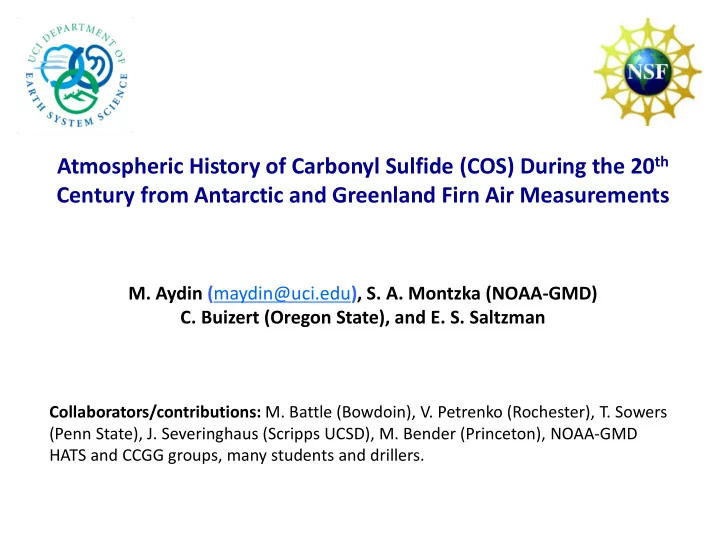

Atmospheric History of Carbonyl Sulfide (COS) During the 20 th Century from Antarctic and Greenland Firn Air Measurements M. Aydin ( maydin@uci.edu ), S. A. Montzka (NOAA-GMD) C. Buizert (Oregon State), and E. S. Saltzman Collaborators/contributions: M. Battle (Bowdoin), V. Petrenko (Rochester), T. Sowers (Penn State), J. Severinghaus (Scripps UCSD), M. Bender (Princeton), NOAA-GMD HATS and CCGG groups, many students and drillers.
COS in the atmosphere – Budget today OH + photolysis Largest sink 80% 10% • COS is used as a proxy for gross primary productivity Largest source 20% 10% • It contributes to background sulfate aerosol in the stratosphere 70% 10% Soils Canopy Anthropogenic Biomass Oceans emit Uptake Emissions Burning COS, CS 2 , DMS Current best estimates: • Mean trop. mixing ratio just Emissions are ~1.2 TgS y -1 under 500 ppt • 1-2% more in the SH Lifetime is ~2 y
Firn air COS records – background Firn air ages non-linearly with depth • • Measurements from a given depth represent average levels over many years • The deeper in the firn, the longer the time scale of averaging Recovery of atmospheric records requires • a formal inversion using firn model outputs (figure on the left) • Inversions benefit from knowing past atmospheric composition (ice core data helps!) Firn data from • 3 Greenland campaigns : Summit (SUM) in 2006 and 2013, Renland in 2015 4 Antarctic campaigns: S. Pole (SPO) in 2001, 2008, 2015, and Mega Dunes in 2003 Inversions conducted separately for NH and SH sites •
Firn air COS measurements and MC sampling – Greenland RED: Measurement means show an • increase at depth and turn around • A statistical model with MCMC sampling to get full Bayesian inference (mc- stan.org) GRAY: Range covered in MC sims (20k • runs) is proportional to estimated uncertainty at each sampling depth • All sites display a COS increase at depth
Firn inversions – Greenland (20k MC sims) More than 95% of sims show peak before 1980 COS at t final is forced COS at t 0 is forced Peak in the atmosphere in the 1970s
Firn air COS measurements – Antarctica (20k MC sims) • Three sites show large decreases at depth • SPO15 does not because the sampling did not reach the bottom
Firn inversion results – Antarctica (20k MC sims) Forced smoothing Ice core data used as BC before 1850 • Antarctic firn data provide a much longer • Record with larger atmospheric record than Greenland variability explains the firn • Antarctic record also displays coherent data better!!! information at higher frequencies • Peak in the 1980s
Firn inversion results – Antarctica (based on 15k MC sims) Peak after 1980
Firn inversions – Greenland vs. Antarctica • Large increase in COS evident in both atmospheres • Peak in both hemispheres in late 20 th century • NH peaks before SH • Peak followed by decline to present day when the levels in two hemispheres are close to equal • Is this variability driven by anthropogenic emission? Ice core data prior to 1850 from both Greenland and Antarctica on a collapsed time scale
Bottom-up anthropogenic COS emissions estimates • Bottom-up estimate of anthropogenic emissions display strong ramp-up in qualitative agreement with firn records • At the peak, anthropogenic emissions account for only 25% of the COS budget • Present-day level is not significantly lower than the peak. Calendar years
6-box ocean-atmosphere model – base case (current budget) From preindustrial to present At the the Poles (60 – 90 deg) • Anthropogenic emissions change • We get present-day levels right similar to bottom-up inventory but no peak(s) in late 20 th century • Small biomass burning increase • Antarctic levels are too high in the following Campbell et al. (2017) preindustrial atmosphere • Oceans set at present day productivity and respond passively • Antarctic always higher than Greenland • Constant uptake rate (lifetime = 2 y)
6-box ocean-atmosphere model – High Anthropogenic • Doubled anthropogenic emission in late 20 th century to get a peak comparable to seen in firn air records • GRLND exceeds ANT at the peak • GRLND and ANT peaks are simultaneous • No impact on preindustrial SH levels
6-box ocean-atmosphere model – High Anthropogenic, Var. Ocean • Lower emissions from mid-high latitude SH oceans during preindustrial era • SH ocean emissions get back to present day levels late in the 20 th century • GRLND higher than ANT most of the time • GRLND and ANT peaks separated in time
Conclusions • Inversions based on firn data from multiple sites display previously undocumented variability in NH and SH atmospheres • Anthropogenic COS emissions were easily double the present day during the second half of the 20 th century • Results suggest ocean production of COS (or may be DMS) possibly changed during the 20 th century • Changes in removal rate cannot be ruled out, but difficult to constrain without understanding the behavior of ocean sources Ongoing work • We are funded to measure COS in a shallow ice core from Greenland, which should provide tighter constraints on Greenland firn inversions
Recommend
More recommend